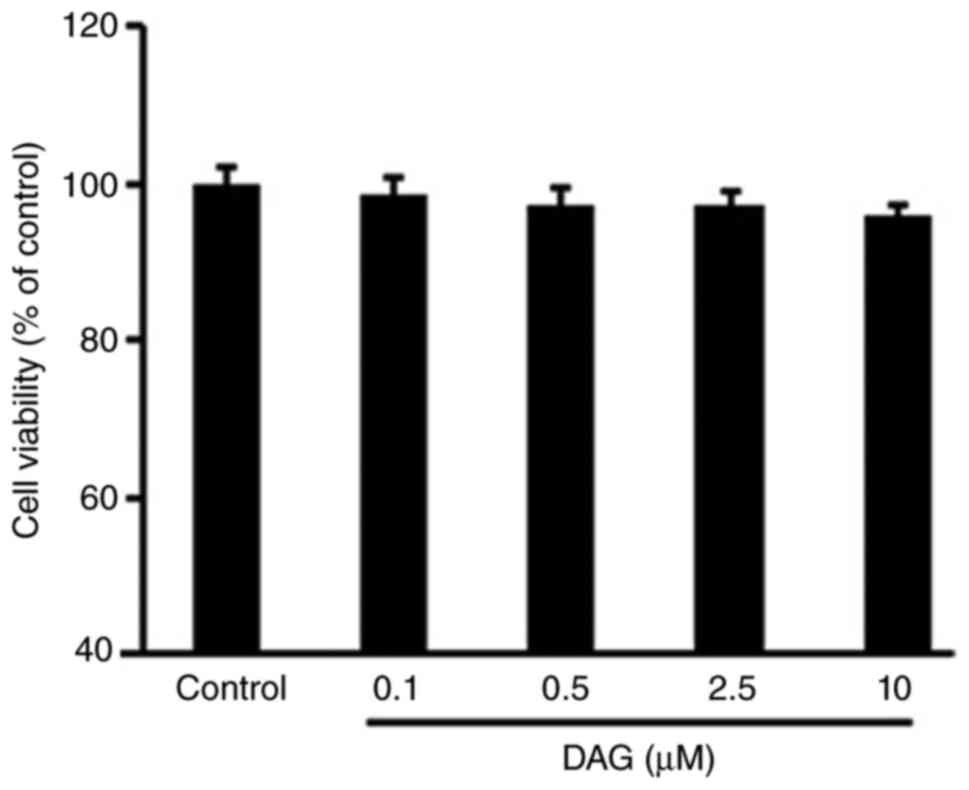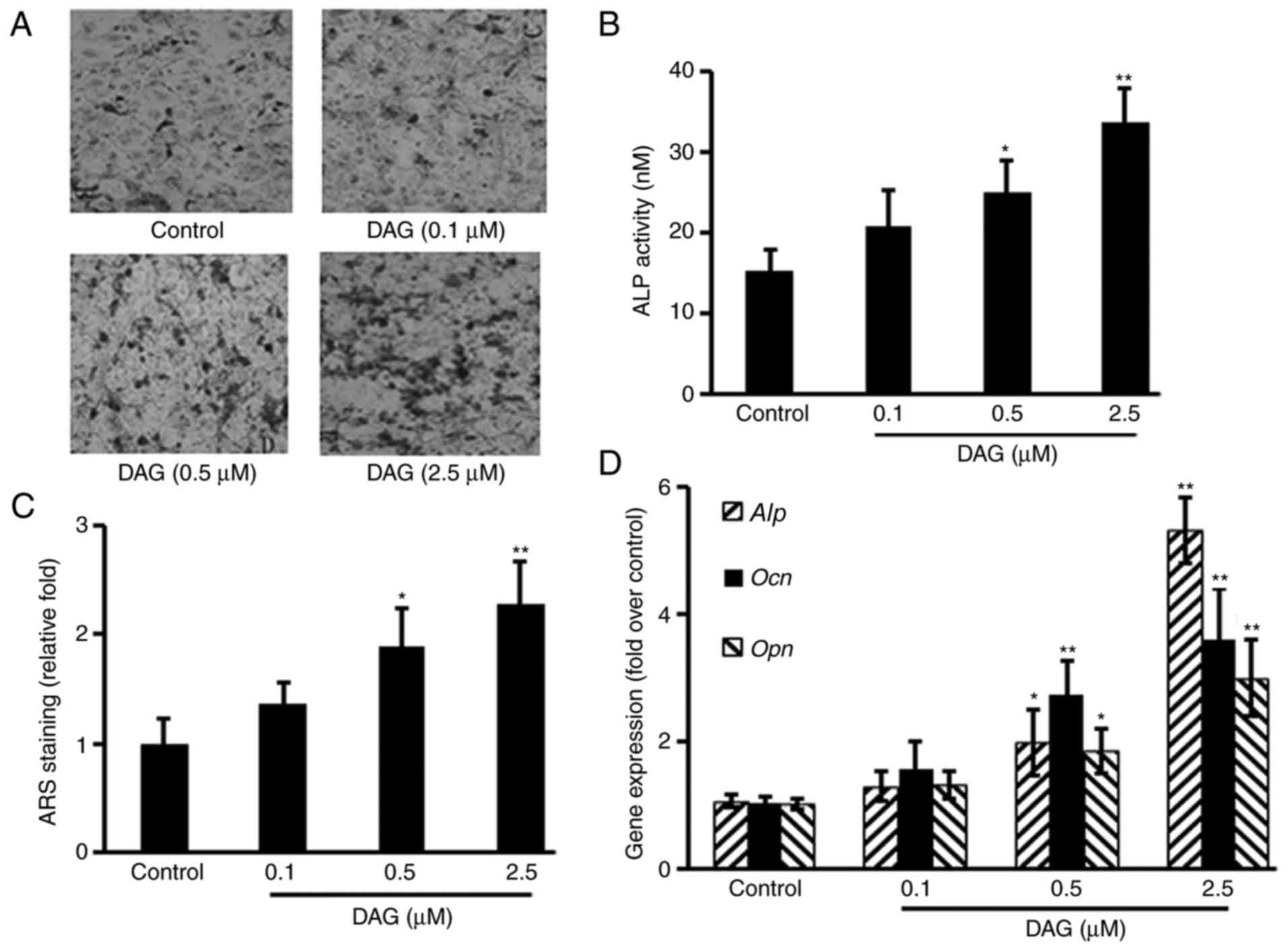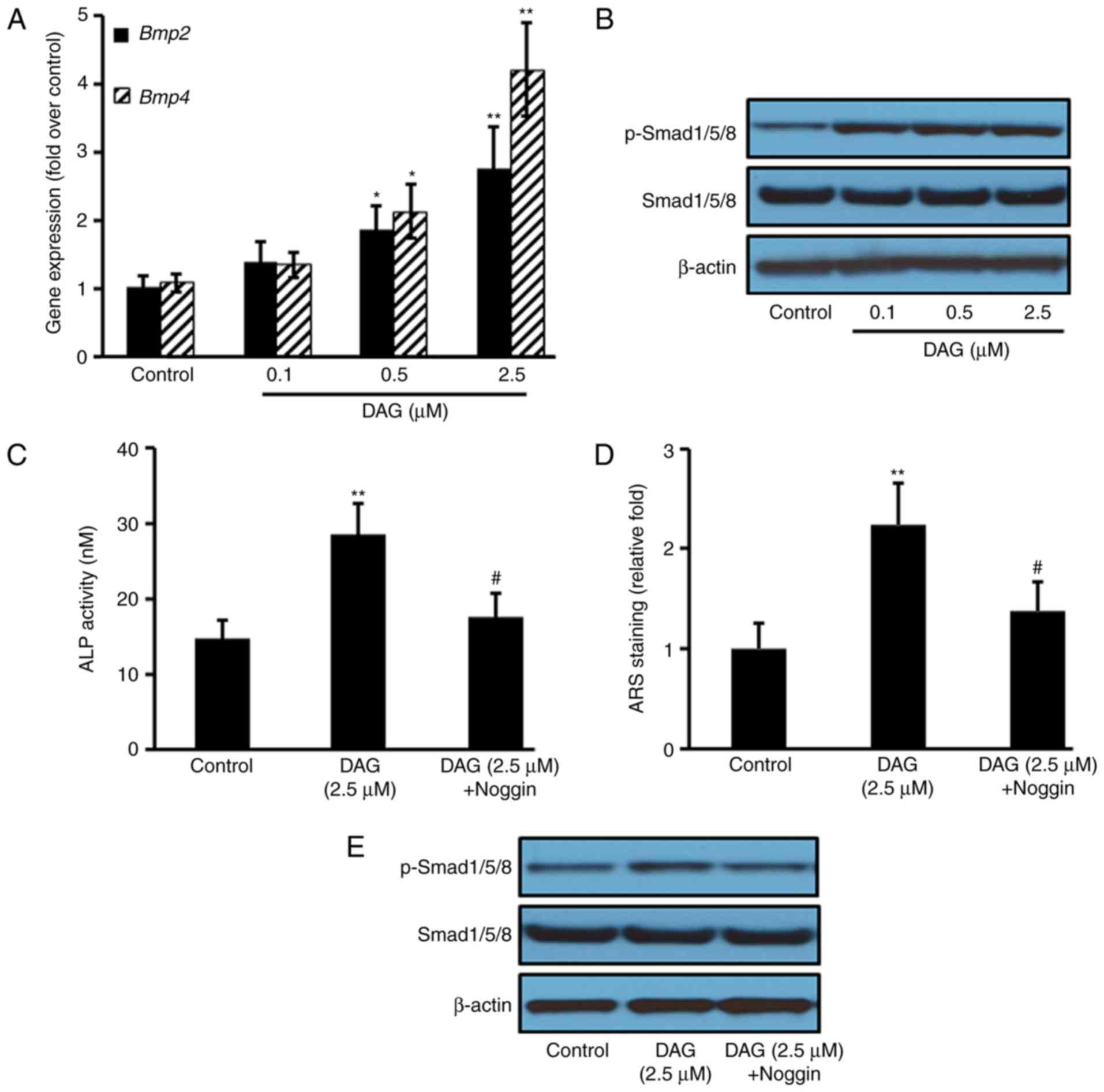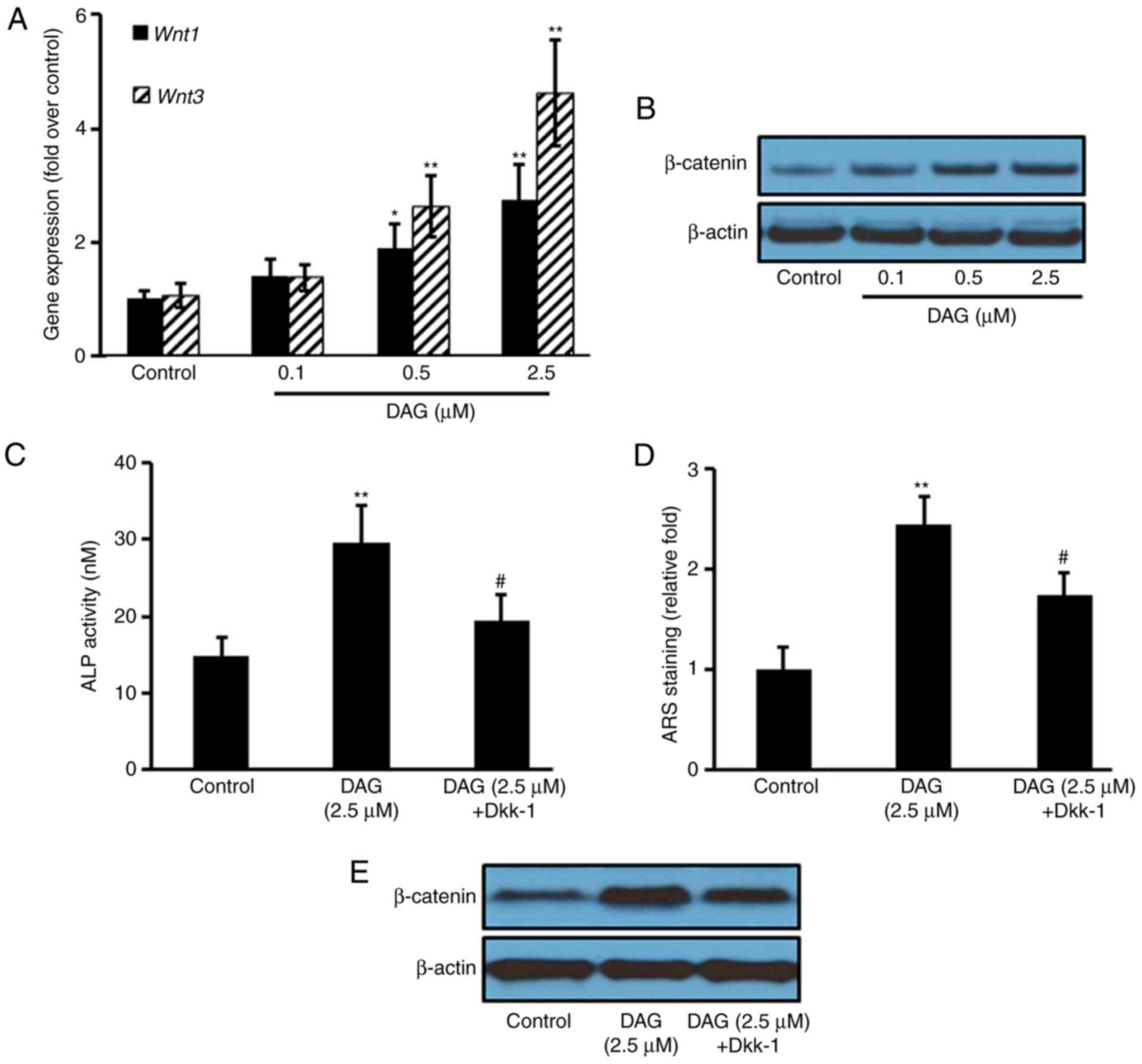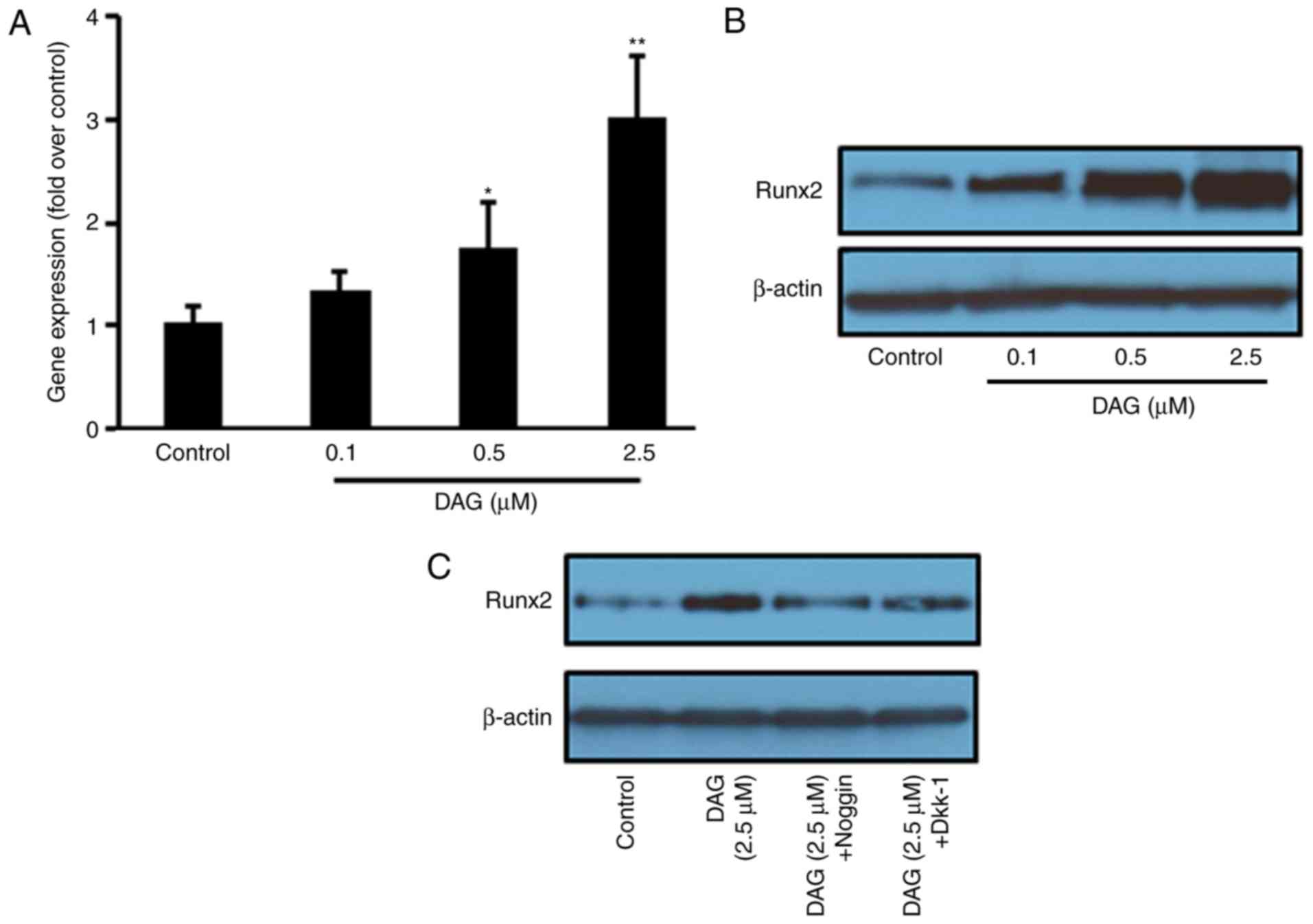(R)‑dehydroxyabscisic alcohol β‑D‑apiofuranosyl‑(1ˮ→6ʼ)‑β‑D‑glucopyranoside enhances the osteoblastic differentiation of ST2 cells via the BMP/WNT pathways
- Authors:
- Published online on: November 23, 2018 https://doi.org/10.3892/mmr.2018.9690
- Pages: 461-467
-
Copyright: © Liu et al. This is an open access article distributed under the terms of Creative Commons Attribution License.
Abstract
Introduction
Bone mass regulation is under the control of continuous bone remodeling, which is a balance of osteoclastic bone resorption and osteoblastic bone formation. Disorders of bone remodeling cause a variety of bone-associated diseases, including osteoporosis (1). Osteoporosis occurs when the body makes too little bone, loses too much bone, or a combination of these two factors. Osteoporotic bones have lost density or mass, and contain abnormal tissue structure. As a result, bones become weak and may easily break following a fall. Current therapies include anti-catabolic drugs, anti-resorptives and anabolic agents (2,3). Unfortunately, the treatments available for individuals with osteoporosis are ineffective due to adverse effects (4). Therefore, it is important to identify novel therapeutic strategies.
As the main bone-forming cells, osteoblasts produce alkaline phosphatase (ALP), and bone matrix proteins such as osteocalcin (OCN) and osteopontin (OPN), which are associated with osteoblastic mineralization (5). Osteoblast differentiation is regulated by bone morphogenetic proteins (BMPs) and WNT family member (WNT) pathways (6,7). BMPs are critically involved in bone formation processes for the maintenance of bone homeostasis and skeletal development (8). The WNT pathway is also essential for bone development (9). In addition, these two pathways cooperate to regulate osteoblast differentiation and bone formation.
Lonicera japonica has been used in traditional Chinese medicine to treat various diseases, including osteoporosis (10,11). As an active component obtained from the flower buds of Lonicera japonica, (R)-dehydroxyabscisic alcohol β-D-apiofuranosyl-(1ˮ→6’)-β-D-glucopyranoside (DAG; Fig. 1) (12), was identified to have potent activity in improving osteoblastic differentiation in our preliminary compound screening. The present study aimed to further investigate the effects of DAG on osteoblastic differentiation and its underlying mechanisms, in order to support the potential development of DAG as a therapeutic agent against bone-associated diseases, such as osteoporosis.
Materials and methods
Materials
The ST2 bone marrow stromal cell line was purchased from Type Culture Collection of the Chinese Academy of Sciences (Shanghai, China). Fetal bovine serum (FBS) and RPMI-1640 medium were obtained from Gibco (Thermo Fisher Scientific, Inc., Waltham, MA, USA). MTT, Alizarin Red S and silver nitride were purchased from Sigma-Aldrich (Merck KGaA, Darmstadt, Germany). Recombinant Noggin was purchased from Sigma-Aldrich (Merck KGaA) and Dickkopf-related protein 1 (Dkk-1) was purchased from PeproTech, Inc. (Rocky Hill, USA). The ALP assay kit was purchased from Nanjing Jiancheng Bioengineering Institute (Nanjing, China). Polymerase chain reaction (PCR) reagents were purchased from Thermo Fisher Scientific, Inc. DAG was provided by Professor Han (Tongji University, Shanghai, China) and was isolated and identified using spectroscopic and HPLC methods with purity >98% (12). All other reagents including DMSO, paraformaldehyde and Triton X-100 were of analytical grade and purchased from Sinopharm Chemical Reagent Co., Ltd. (Shanghai, China). DAG was dissolved in dimethyl sulfoxide (DMSO) for the in vitro experiments.
Cell culture and treatment
ST2 cells were cultured in RPMI-1640 medium supplemented with 15% FBS, 1% streptomycin-penicillin and osteogenic differentiation medium (cat. no. A1007201; Thermo Fisher Scientific, Inc., Waltham, MA, USA) in a 37°C and 5% CO2 incubator. In the cell viability assays, ST2 cells were treated with DAG at 0.1, 0.5 or 2.5 µM for 72 h at 37°C; in other treatments, ST2 cells were treated with DAG at 0.1, 0.5 or 2.5 µM at 37°C for different time periods according to the assays (14 days for von Kossa staining; 5 days for ALP activity; 14 days for ARS staining; 7 days for gene expression); in the mechanistic studies, ST2 cells were pretreated with Noggin (10 µg/ml) or Dkk-1 (0.5 µg/ml) for 1 h at 37°C, and then treated with DAG at 2.5 µM for different time periods according to the assays at 37°C (14 days for von Kossa staining; 5 days for ALP activity; 14 days for ARS staining; 7 days for gene expression; 10 days for protein expression); cells were treated with DMSO as the negative control.
Cell viability measurement
An MTT assay was performed to determine cell viability. Treated ST2 cells were seeded into 96-well plates at a density of 3×104/100 µl. MTT solution (10 µl) was added to each well, and incubated for 4 h at 37°C. DMSO (200 µl) was subsequently added into each well to dissolve the formazan. The absorbance was measured by a plate reader at 570 nm.
ALP activity measurement
Following treatment, ST2 cells were collected and lysed using 0.1% Triton X-100 (Sinopharm Chemical Reagent Co., Ltd.). ALP activity was measured using the cALP stain kit (cat. no. D001-1; Nanjing Jiancheng BioEngineering Institute Co., Ltd.) according to the manufacturer's instructions.
Von Kossa staining
Treated ST2 cells were washed twice with PBS and fixed with 4% paraformaldehyde for 15 min at 4°C. Following washing with PBS, cells were stained with 5% silver nitride under UV radiation for 30 min at room temperature. The stained cells were washed twice and observed using an Olympus BX60 light microscope (magnification, ×40; Olympus Corporation, Tokyo, Japan).
Alizarin Red S staining
Treated ST2 cells were washed twice with PBS and fixed in 70% ice-cold ethanol for 1 h. Following another wash, cells were stained with 40 mM Alizarin Red S (pH 4.2) for 10 min at room temperature. The stains were eluted with DMSO to quantify the amount of Alizarin Red S staining, by measuring the absorbance at 570 nm.
Reverse transcription-quantitative PCR (RT-qPCR)
Following treatment, ST2 cells were collected and total RNA was extracted with TRIzol® reagent. RNA (0.4 µg) was used to generate cDNA using an iScript™ Reverse Transcription Supermix kit (Bio-Rad Laboratories, Inc., Hercules, CA, USA) at 25°C for 5 min, 46°C for 20 min and 95°C for 1 min. qPCR was run with the SYBR-Green ER™ qPCR SuperMix Universal (cat. no. 11762100; Thermo Fisher Scientific, Inc.) on a MX3000p system (Stratagene; Agilent Technologies, Inc., Santa Clara, CA, USA) (95°C for 10 min, 95°C for 15 sec and 60°C for 60 sec; 40 cycles), using the comparative Cq value method to quantify the target gene expression in different samples (13). The gene expression was normalized using the housekeeping gene β-actin. The gene-specific primer sequences were as follows: Alp forward, 5′-GCTGATCATTCCCACGTTTT-3′ and reverse, 3′-CTGGGCCTGGTAGTTGTTGT-5′ (GenBank reference, X13409.1); Ocn forward, 5′-CTTGGGTTCTGACTGGGTGT-3′ and reverse, 3′-GCCCTCTGCAGGTCATAGAG-5′ (GenBank reference, L24431.1); Opn forward, 5′-TGCACCCAGATCCTATAGCC-3′ and reverse, 3′-CTCCATCGTCATCATCATCG-5′ (GenBank reference, AF515708.1); Bmp2 forward, 5′-CCCCAAGACACAGTTCCCTA-3′ and reverse, 3′-GAGACCGCAGTCCGTCTAAG-5′ (NCBI reference: NM_007553.3); Bmp4 forward, 5′-TCTAGAGGTCCCCAGAAGCA-3′ and reverse, 3′-CTTCCCGGTCTCAGGTATCA-5′ (GenBank reference, BC034053.1); Wnt1 forward, 5′-ACAGCAACCACAGTCGTCAG-3′ and reverse, 3′-GAATCCGTCAACAGGTTCGT-5′ (NCBI reference, NM_021279.4); Wnt3 forward, 5′-GCGACTTCCTCAAGGACAAG-3′ and reverse, 3′-AAAGTTGGGGGAGTTCTCGT-5′ (NCBI reference, NM_009521.2); runt related transcription factor 2 (Runx2) forward, 5′-CCCAGCCACCTTTACCTACA-3′ and reverse, 3′-TATGGAGTGCTGCTGGTCTG-5′ (NCBI reference, NM_001145920.2); β-actin forward, 5′-AGCCATGTACGTAGCCATCC-3′ and reverse, 3′-CTCTCAGCTGTGGTGGTGAA-5′ (NCBI reference, NM_007393.5).
Western blot analysis
Treated ST2 cells were collected to extract protein with RIPA lysis buffer (cat. no. 89900; Thermo Fisher Scientific, Inc.). The protein concentration was determined by a bicinchoninic acid protein assay kit. Protein samples of equal quantity (40 µg/lane) were subjected to 4–12% (v/v) SDS-PAGE. Proteins were subsequently transferred onto polyvinylidene fluoride membranes. Following blocking with 5% dried skimmed milk for 1 h at room temperature, membranes were washed three times with PBS/T (PBS containing 0.1%/Tween-20) and incubated with the following primary antibodies: Anti-mothers against decapentaplegic homolog (Smad)1/5/8 (cat. no. sc-6031-R; 1:1,000; Santa Cruz Biotechnology, Inc., Dallas, TX, USA), anti-phosphorylated (p)-Smad1/5/8 (cat. no. AB3848-I; 1:500; EMD Millipore, Billerica, MA, USA), anti-β-catenin (cat. no. sc-7199; 1:500, Santa Cruz Biotechnology, Inc.), anti-Runx2 (cat. no. sc-10758; 1:500; Santa Cruz Biotechnology, Inc.) and anti-β-actin (cat. no. ab8227; 1:5,000, Abcam, Cambridge, UK) at 4°C overnight. Following washing with PBS, the membranes were further incubated with horseradish peroxidase-conjugated goat anti-rabbit immunoglobulin G secondary antibody (cat. no. ab6721; 1:8,000; Abcam) for 1 h at room temperature. Following washing, membranes were exposed to Pierce™ enhanced chemiluminescence substrate (Thermo Fisher Scientific, Inc.) followed by X-ray film development.
Statistical analysis
Data was analyzed by one-way analysis of variance with SAS version 9.1 software (SAS Institute, Inc., Cary, NC, USA) followed by Dunnett's t-test. Values were expressed as the mean ± standard deviation. P<0.05 was considered to indicate as statistically significant difference.
Results
DAG does not affect ST2 cell viability
ST2 cells were treated with DAG at different concentrations for 72 h. DAG treatment did not result in any significant cytotoxic effects when compared with the negative control, as presented in Fig. 1.
DAG treatment induces ST2 cell osteoblastic differentiation
To study the effects of DAG on osteoblastic differentiation, ST2 cells were treated with DAG at various concentrations. The results demonstrated that DAG increased the osteoblastic differentiation of ST2 cells, as evidenced by increased mineralized nodule formation measured by von Kossa staining (Fig. 2A), ALP activity (Fig. 2B) and calcium deposits measured by ARS staining (Fig. 2C) in a dose-dependent manner, as well as by the upregulation of Alp, Ocn and Opn gene expression (Fig. 2D).
DAG treatment activates the BMP signaling pathway
To investigate the signaling pathways involved in the osteoblastic differentiation of ST2 cells induced by DAG, the BMP pathway was analyzed by RT-qPCR and western blotting. The results demonstrated that compared with the control group, DAG treatment increased the gene expression of Bmp2 and Bmp4 (Fig. 3A), as well as the protein expression of p-Smad1, 5 and 8 (Fig. 3B). Pretreating the ST1 cells with the BMP antagonist Noggin for 1 h prior to DAG treatment significantly reduced the DAG-mediated increase in ALP levels (Fig. 4C) and mineralization (Fig. 4D), as well as the protein expression of p-Smad1, 5 and 8 (Fig. 4E).
DAG treatment activates the WNT signaling pathway
To further investigate the signaling pathways involved in the osteoblastic differentiation of ST2 cells induced by DAG, WNT pathway gene and protein expression was analyzed. The results revealed that DAG treatment increased the gene expression of Wnt1 and 3 (Fig. 4A), as well as the protein expression of β-catenin (Fig. 4B). Pretreating the ST1 cells with the WNT inhibitor Dkk-1 for 1 h prior to DAG treatment significantly attenuated the DAG-mediated increase in ALP levels (Fig. 4C) and mineralization (Fig. 4D), as well as the protein expression of β-catenin (Fig. 4E).
DAG treatment increases Runx2 expression
To further confirm that the DAG-induced osteoblastic differentiation of ST2 cells occurred through the BMP and WNT signaling pathways, the expression of Runx2, a key transcription factor in osteoblastic differentiation, was measured following DAG treatment. The results demonstrated that DAG treatment increased the gene (Fig. 5A) and protein (Fig. 5B) expression of Runx2. Noggin and Dkk-1 pretreatment significantly inhibited the DAG-stimulated increase in Runx2 protein expression (Fig. 5C).
Discussion
Osteoporosis is the most common bone-associated disease, characterized by increased bone fragility and decreased bone mass (14). As an important process of bone formation, osteoblastic differentiation is severely compromised in osteoporosis. Therefore, promoting osteoblastic differentiation is an effective strategy to prevent pathological progression. In the present study, it was demonstrated that DAG, a novel compound from the flower buds of Lonicera japonica, had no toxicity on bone marrow stromal cells and increased osteoblastic differentiation. DAG differs from WIN-34B, another compound isolated from Lonicera japonica, which has been demonstrated to increase osteogenesis and decrease osteoclastogenesis via promoting ALP activity and mineralization of human mesenchymal stem cells through inhibition of the NF-κB, JNK and p38 MAPK pathways (10). The present study demonstrated that DAG exerted its effects by activating the BMP/WNT signaling pathways.
The ST2 cell line has been widely used for the study of osteoblastic differentiation, as these differentiate into osteoblast-like cells and further mature into osteoblasts (15,16). The process of new bone formation involves osteoblast differentiation and proliferation, and finally extracellular matrix mineralization. ALP activity is a well-recognized marker of early osteoblast differentiation, and the mineralization may be detected by von Kossa staining and Alizarin Red S staining, as a biological marker of the terminal differentiation (17,18). In the present study, ST2 cells treated with DAG significantly increased ALP activity and mineralization, and upregulated the gene expression of Alp, Ocn and Opn, suggesting that DAG stimulated early and late osteoblastic differentiation, as well as maturation.
BMP family proteins serve an important role in the regulation of bone remodeling and formation, as one of the main signaling cascades (19). Inactive BMP resides in the cytoplasm, and upon activation by p-Smad1/5/8, it translocates to the nucleus to regulate the transcription of target genes (20). Several compounds have been reported to promote osteoblastic differentiation through activating the BMP signaling pathway (21,22). In the present study, DAG treatment increased the gene expression of Bmp, as well as the protein expression of phosphorylated Smad1/5/8. Furthermore, the BMP antagonist Noggin significantly inhibited DAG-induced ALP activity and mineralization, further confirming that DAG induced osteoblastic differentiation through the BMP signaling pathway.
WNT/β-catenin signaling contributes to osteoblastic differentiation, as another critical pathway that regulates bone remodeling and formation (23). WNT ligands bind with Frizzled, low density lipoprotein receptor-related protein (LRP) 5 and LRP6 receptors to stabilize β-catenin in the cytoplasm, resulting in the translocation of β-catenin into the nucleus to regulate osteoblastic differentiation-associated gene expression (24,25). The results of the present study revealed that treating ST2 cells with DAG increased the gene expression of Wnt ligands and the protein expression of β-catenin. Furthermore, the DAG-induced osteogenic effects were attenuated by the WNT inhibitor Dkk-1, indicating that WNT/β-catenin signaling was involved in DAG-induced osteoblastic differentiation.
Runx2 is a downstream regulator of the WNT/BMP signaling pathways, which is essential in the process of osteoblastic differentiation (26). The present results indicated that DAG treatment increased Runx2 gene and protein expression in ST2 cells, implying that functional cross-talk existed between the WNT/BMP pathways.
In conclusion, the present study demonstrated that DAG isolated from the flower buds of Lonicera japonica stimulated the osteoblastic differentiation of ST2 cells through the WNT/BMP signaling pathways. This provides scientific rationale for the development of DAG as a therapeutic agent against bone diseases, such as osteoporosis.
Acknowledgements
The authors thank Professor Han from Tongji University (Shanghai, China) for providing DAG in this study.
Funding
Not applicable.
Availability of data and materials
The data and materials are available from the corresponding author upon reasonable request.
Authors' contributions
Study concept and design was by WZ; experimental studies by YL, TY, TC and JH; data analysis was by YL, TC and YG; manuscript preparation by YL, TY, TC, JH, YG and WZ. All authors read and approved the final manuscript.
Ethics approval and consent to participate
Not applicable.
Patient consent for publication
Not applicable.
Competing interests
The authors declare that they have no competing interests.
References
|
Rodan GA and Martin TJ: Therapeutic approaches to bone diseases. Science. 289:1508–1514. 2000. View Article : Google Scholar : PubMed/NCBI | |
|
Riggs BL and Parfitt AM: Drugs used to treat osteoporosis: The critical need for a uniform nomenclature based on their action on bone remodeling. J Bone Miner Res. 20:177–184. 2005. View Article : Google Scholar : PubMed/NCBI | |
|
Augustine M and Horwitz MJ: Parathyroid hormone and parathyroid hormone-related protein analogs as therapies for osteoporosis. Curr Osteoporos Rep. 11:400–406. 2013. View Article : Google Scholar : PubMed/NCBI | |
|
Skjødt MK, Frost M and Abrahamsen B: Side effects of drugs for osteoporosis and metastatic bone disease. Br J Clin Pharmacol. 2018.(Epub ahead of print). doi: 10.1111/bcp.13759. View Article : Google Scholar | |
|
Long F: Building strong bones: Molecular regulation of the osteoblast lineage. Nat Rev Mol Cell Biol. 13:27–38. 2011. View Article : Google Scholar : PubMed/NCBI | |
|
Huang W, Yang S, Shao J and Li YP: Signaling and transcriptional regulation in osteoblast commitment and differentiation. Front Biosci. 12:3068–3092. 2007. View Article : Google Scholar : PubMed/NCBI | |
|
Rawadi G and Roman-Roman S: Wnt signaling pathway: A new target for the treatment of osteoporosis. Expert Opin Ther Targets. 9:1063–1077. 2005. View Article : Google Scholar : PubMed/NCBI | |
|
Kamiya N: The role of BMPs in bone anabolism and their potential targets SOST and DKK1. Curr Mol Pharmacol. 5:153–163. 2012. View Article : Google Scholar : PubMed/NCBI | |
|
Pinzone JJ, Hall BM, Thudi NK, Vonau M, Qiang YW, Rosol TJ and Shaughnessy JD Jr: The role of Dickkopf-1 in bone development, homeostasis, and disease. Blood. 113:517–525. 2009. View Article : Google Scholar : PubMed/NCBI | |
|
Seo BK, Ryu HK, Park YC, Huh JE and Baek YH: Dual effect of WIN-34B on osteogenesis and osteoclastogenesis in cytokine-induced mesenchymal stem cells and bone marrow cells. J Ethnopharmacol. 193:227–236. 2016. View Article : Google Scholar : PubMed/NCBI | |
|
Li Y, Cai W, Weng X, Li Q, Wang Y, Chen Y, Zhang W, Yang Q, Guo Y, Zhu X, et al: Lonicerae Japonicae flos and lonicerae flos: A systematic pharmacology review. Evid Based Complement Alternat Med. 2015:9050632015.PubMed/NCBI | |
|
Xu JR, Li GF, Wang JY, Zhou JR and Han J: Gout prophylactic constituents from the flower buds of Lonicera japonica. Phytochem Lett. 15:98–102. 2016. View Article : Google Scholar | |
|
Livak KJ and Schmittgen TD: Analysis of relative gene expression data using real-time quantitative PCR and the 2ΔΔCT method. Methods. 25:402–408. 2001. View Article : Google Scholar : PubMed/NCBI | |
|
Marie PJ and Kassem M: Osteoblasts in osteoporosis: Past, emerging, and future anabolic targets. Eur J Endocrinol. 165:1–10. 2011. View Article : Google Scholar : PubMed/NCBI | |
|
Otsuka E, Yamaguchi A, Hirose S and Hagiwara H: Characterization of osteoblastic differentiation of stromal cell line ST2 that is induced by ascorbic acid. Am J Physiol. 277:C132–C138. 1999. View Article : Google Scholar : PubMed/NCBI | |
|
Yamaguchi A, Ishizuya T, Kintou N, Wada Y, Katagiri T, Wozney JM, Rosen V and Yoshiki S: Effects of BMP-2, BMP-4, and BMP-6 on osteoblastic differentiation of bone marrow-derived stromal cell lines, ST2 and MC3T3-G2/PA6. Biochem Biophys Res Commun. 220:366–371. 1996. View Article : Google Scholar : PubMed/NCBI | |
|
Kim MB, Song Y and Hwang JK: Kirenol stimulates osteoblast differentiation through activation of the BMP and Wnt/β-catenin signaling pathways in MC3T3-E1 cells. Fitoterapia. 98:59–65. 2014. View Article : Google Scholar : PubMed/NCBI | |
|
Aubin JE: Bone stem cells. J Cell Biochem Suppl. 30-31:73–82. 1998. View Article : Google Scholar : PubMed/NCBI | |
|
Wan M and Cao X: BMP signaling in skeletal development. Biochem Biophys Res Commun. 328:651–657. 2005. View Article : Google Scholar : PubMed/NCBI | |
|
Zhao M, Harris SE, Horn D, Geng Z, Nishimura R, Mundy GR and Chen D: Bone morphogenetic protein receptor signaling is necessary for normal murine postnatal bone formation. J Cell Biol. 157:1049–1060. 2002. View Article : Google Scholar : PubMed/NCBI | |
|
Jia TL, Wang HZ, Xie LP, Wang XY and Zhang RQ: Daidzein enhances osteoblast growth that may be mediated by increased bone morphogenetic protein (BMP) production. Biochem Pharmacol. 65:709–715. 2003. View Article : Google Scholar : PubMed/NCBI | |
|
Lo YC, Chang YH, Wei BL, Huang YL and Chiou WF: Betulinic acid stimulates the differentiation and mineralization of osteoblastic MC3T3-E1 cells: Involvement of BMP/Runx2 and beta-catenin signals. J Agric Food Chem. 58:6643–6649. 2010. View Article : Google Scholar : PubMed/NCBI | |
|
Krishnan V, Bryant HU and Macdougald OA: Regulation of bone mass by Wnt signaling. J Clin Invest. 116:1202–1209. 2006. View Article : Google Scholar : PubMed/NCBI | |
|
MacDonald BT and He X: Frizzled and LRP5/6 receptors for Wnt/β-catenin signaling. Cold Spring Harb Perspect Biol. 4(pii): a0078802012.PubMed/NCBI | |
|
Kikuchi A: Regulation of beta-catenin signaling in the Wnt pathway. Biochem Biophys Res Commun. 268:243–248. 2000. View Article : Google Scholar : PubMed/NCBI | |
|
Lee MH, Kim YJ, Kim HJ, Park HD, Kang AR, Kyung HM, Sung JH, Wozney JM, Kim HJ and Ryoo HM: BMP-2-induced Runx2 expression is mediated by Dlx5, and TGF-beta 1 opposes the BMP-2-induced osteoblast differentiation by suppression of Dlx5 expression. J Biol Chem. 278:34387–34394. 2003. View Article : Google Scholar : PubMed/NCBI |



